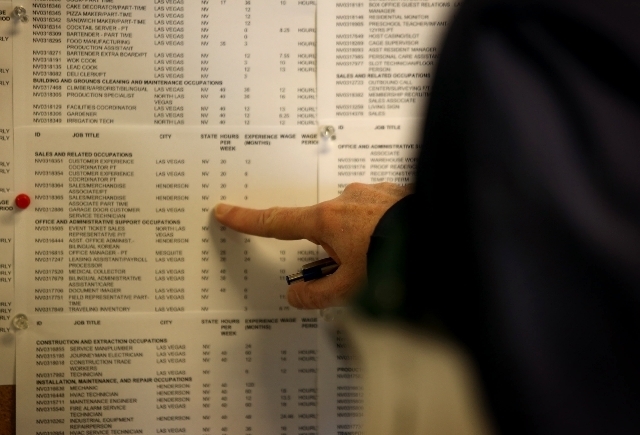Nevada seen reclaiming prerecession jobs peak in two years
The summit is in sight.
Nevada’s job growth continued to power upward through October, and with employment gains projected to jump still more through 2017, Nevada should climb back to its prerecession jobs peak in about two years, state economists said Friday.
Expect that growth rate to include blistering gains in construction, which could bounce back statewide to around 100,000 jobs — two-thirds of its boom-era high.
Before we detail those forecasts, here’s where we are now.
Unemployment fell statewide to 7.1 percent in October, down from 7.3 percent in September and 9.4 percent in October 2013, the Nevada Department of Employment, Training and Rehabilitation reported Friday.
It was the 45th straight month of year-to-year jobless declines and the lowest statewide unemployment level since June 2008.
The Las Vegas rate dipped to 6.8 percent, compared with 7.1 percent a month earlier and 9.6 percent a year ago, but local rates are not seasonally adjusted and can swing more dramatically than state numbers. What’s more, unemployment in all 17 Nevada counties slipped below 10 percent for the first time since the recession’s 2007 start.
“Nevada’s job growth rank has been steadily climbing, outperforming 48 other states in terms of employment growth of late,” said Bill Anderson, the employment department’s chief economist. “After a long delay, this strong employment growth has finally led to an accelerated decline in the state’s unemployment rate.”
Nevada had 28,600 more jobs in October than it had a year earlier. That’s an annual expansion rate of 2.4 percent. Count from January through October, and Nevada had 41,300 more jobs than it had in the same period of 2013, for a 3.5 percent gain. That improvement was second to North Dakota’s. Nationally, job formation is averaging 1.9 percent.
Employers shed a seasonally adjusted 7,300 jobs here from September to October, but Anderson said that figure could be a statistical anomaly based on how federal and state analysts gather their data. Jobless numbers come from phone surveys of homes and businesses, as well as information on first-time claims for unemployment benefits. When the employment department revises its estimates in the spring, October’s data “may look a lot different,” Anderson said.
Anderson’s department projects statewide job growth of 3.4 percent in 2015, 3.6 percent in 2016 and 3.8 percent in 2017. That’s the equivalent of 40,000 to 50,000 new jobs in the next three years. If that forecast holds, Anderson said, Nevada should recapture its March 2007 peak jobs base of 1.297 million sometime in late 2016 or early 2017 — roughly 10 years after the recession hit.
With big, new projects planned or underway, including Tesla’s Gigafactory outside Reno and Genting Group’s Resorts World Las Vegas on the Strip, the building industry’s jobs base will grow by an anticipated 12.1 percent in 2015 and 2016 and 12.4 percent in 2017. At that pace of 8,000 to 10,000 new jobs a year, the sector should have about 100,000 employees in 2017, still below a 2006 peak of around 150,000 but roughly twice its recessionary low of 47,000.
But this recovery isn’t just about construction. Job gains have been — and will continue to be — broad-based, reaching across many of Nevada’s 10 biggest employment sectors, said Brian Gordon, a principal in local research firm Applied Analysis.
Despite surging job growth, Nevada continued to lag national unemployment, which averaged 5.8 percent in October.
The Silver State slipped in October to No. 5 for joblessness, tied with Michigan and Tennessee and behind Georgia, Mississippi, Rhode Island and California. In California, joblessness was 7.3 percent.
Nevada’s jobs boom has left considerable numbers of residents behind. Include discouraged workers who have quit job-hunting and underemployed part-timers who would rather work full time, and the state’s jobless rate averaged 15.9 percent from the fourth quarter of 2013 to the third quarter of 2014, according to the U.S. Bureau of Labor Statistics. That was the highest rate in the nation and well above the U.S. average of 12.5 percent.
Contact Jennifer Robison at jrobison@reviewjournal.com. Find her on Twitter: @J_Robison1

















